Intel Broadwell Architecture Preview: A Glimpse into Core M
by Ryan Smith on August 11, 2014 12:01 PM ESTPutting It All Together: Low Power Core M
So far we’ve discussed Broadwell’s architecture on a broad basis, focusing on features and optimizations that are fundamental to the architecture. However to talk about the Broadwell architecture is not enough to fully explain the Core M itself. Though many of Core M’s improvements do come from Broadwell, Intel has also made a number of alterations to everything from the CPU packaging to the process node itself specifically for Core M. It’s the resulting combination of these factors that has allowed Intel to iterate on Broadwell-Y over Haswell-Y, and why Intel is so confident in Broadwell-Y’s capabilities and suitability for mobile form factors.
When it comes to building and configuring Core M, Intel likes to refer to their efforts as the “Fanless Challenge,” reflecting the fact that their biggest goal with Core M is to comfortably get the processor in to 10” tablets under 10mm in thickness that are passively cooled. A big part of getting into such a device is meeting the heat dissipation limitations of the form factor – a 10” tablet under 10mm would require a sub-5W SoC – which is where a lot of Intel’s engineering efforts have gone. Broadwell’s performance optimizations, the GPU optimizations, GPU duty cycling, and the 14nm process all contribute to getting a Core CPU’s power consumption down to that level.
But even that’s still not enough, and for Core M Intel went so far as to give Broadwell-Y its own die and design a low-power optimized version of their 14nm process just for it. This variant is designed to further reduce power consumption by optimizing the resulting transistors for lower power, lower voltage, lower clockspeed operation. By doing this Intel was able to further reduce power consumption in all of the major areas over what would be a traditional 14nm Intel process.
In the resulting 14nm Broadwell-Y process, voltage, capacitance, and leakage were all improved over the traditional 14nm process. Capacitance was reduced by 15%, minimum operating voltages by 10%, and leakage was improved to the point that it reduced SoC power consumption by 10%. The combination of all of these factors serves to significantly lower power consumption over what Intel’s traditional 14nm process would provide.
Working in concert with Broadwell-Y’s 14nm process, Intel has made a number of other changes to further reduce power consumption. Some of these are reflected in Broadwell’s overall design and others are unique to Broadwell-Y, such as using a lower TjMax for Broadwell-Y. By reducing the maximum operating temperature of the chip Intel has been able to realize further power savings by further reducing voltage and decreasing the maximum amount of temperature-dependent leakage the SoC will experience.
Meanwhile Broadwell-Y’s partner in crime, the on-package PCH, has received its own optimizations to reduce power consumption on the SoC’s total power consumption. The PCH itself is not much of a power hog in the first place – it’s still made on Intel’s 32nm process for this and cost reasons – but with such a strong focus on power consumption every watt ends up counting. As a result the Broadwell PCH-LP has seen optimizations that cut its idle power consumption by 25% and its active power consumption by 20%. Further improvements to the PCH’s monitoring hardware also mean it’s more responsive and can be controlled to a finer degree than the Haswell PCH-LP, and Intel has upgraded to a faster audio DSP to improve performance and reduce power consumption there as well.
Feeding all of that silicon in turn is Intel’s second generation Fully Integrated Voltage Regulator (FIVR), which further builds off of Intel’s other optimizations. The 2nd gen FIVR has been tuned for Broadwell-Y’s lower voltages, making the FIVR itself more efficient when delivering power at those voltages. To accomplish this Intel has implemented non-linear vDroop control, which is designed to better control the voltage when workload changes would cause voltage overshoots that waste power. And when even the 2nd gen FIVR isn’t efficient enough, this latest FIVR offers a second mode (LVR Mode) for low voltage/workload situations where the FIVR can be partially bypassed to reduce the FIVR’s power consumption.
Interestingly Broadwell-Y also sees the voltage regulation inductors redesigned and relocated in both the name of power efficiency and space efficiency. We’ll get to the case of space efficiency in a moment, but for power efficiency the new 3D inductors (3DLs) have been placed on the underside of the package, allowing the use of more efficient inductors that waste less power.
This brings us to the final element of Intel’s power optimization efforts, which involve further adjustments to turbo boost as part of Intel’s “hurry up and go to sleep” motto. New for Broadwell-Y is a 3rd power state, PL3, which allows for even greater turbo boosting, but for only a very limited period of time – on the order of milliseconds. PL3 represents the maximum amount of power the device battery can deliver, and while it’s okay to reach this value sparingly, PL3 is a fast drain that is very hard on the battery. The existence of PL3 in this case is as much for battery protection as it is for performance; it allows devices to tap into PL3 power levels on occasion, all the while allowing PL2 (the regular burst limit) to be defined at a safer value below the battery’s limit. Put another way, by knowing PL3 devices know how to stay farther away from it, which in the long run is what’s best for battery reliability.


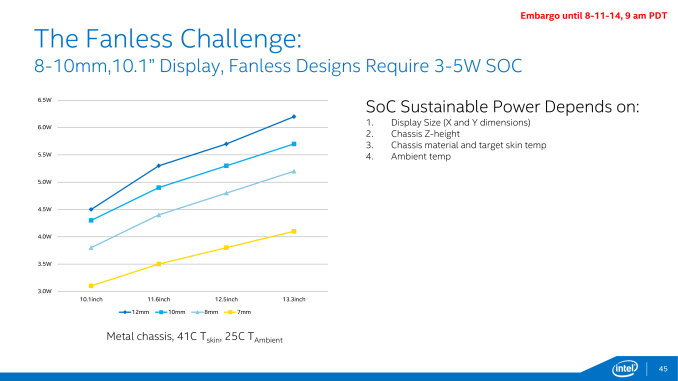
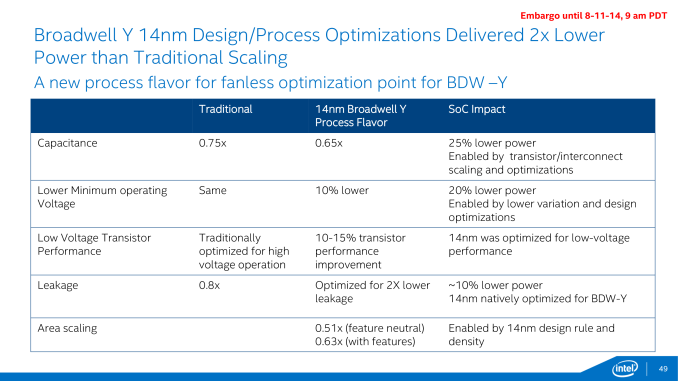
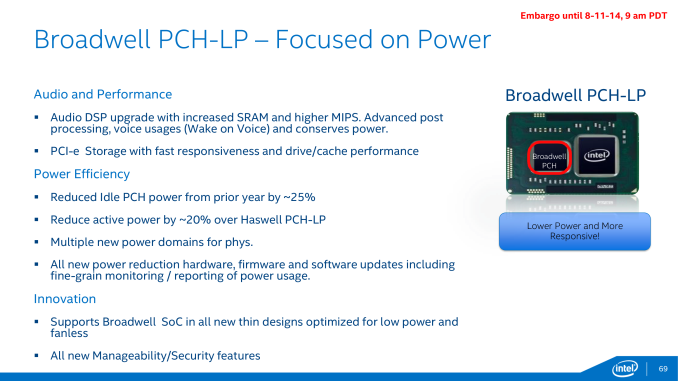
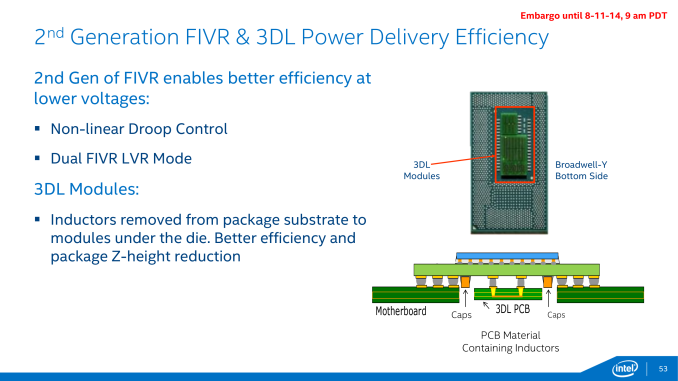

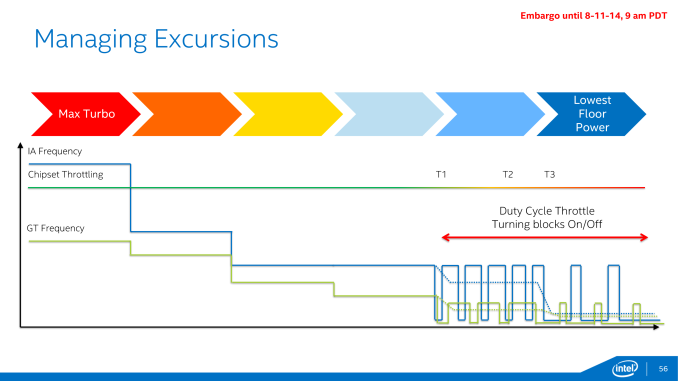








158 Comments
View All Comments
Morawka - Monday, August 11, 2014 - link
wasn't gartner the one who said apple mac sales were down 40% and it turned out to be up 60%mkozakewich - Thursday, August 14, 2014 - link
Those weren't actual numbers, they were industry guesses. The lesson is not to trust pundits and "Industry analysts". If you can wait for proper news to be released, it's better than rumours.lilmoe - Monday, August 11, 2014 - link
Actually, the tablet market as a cause for dropping PC sales is only half or less than half of the story. Logically speaking, most consumers find their 2-4 year old machines sufficient for their "productive" needs. Unlike previous years, PCs are living far beyond their intended years of services, and consumers are in no dire need for newer, faster components. Mind you, hardware isn't getting that much faster with each iteration (relatively speaking), and a simple SSD upgrade and/or more RAM would improve performance significantly that a whole hardware upgrade becomes less appealing (same for other components). It's mostly about convenience, connectivity and mobility for consumers these days (cheap mobile media consumption) that's why the tablet market "appear" to have affected PC sales. Those who find a tablet replacing their fully fledged PC didn't need a PC in the first place.mayankleoboy1 - Monday, August 11, 2014 - link
i remember being very excited to read the Haswell architecture preview.Felt completely disappointed when the actual CPU were reviewed.
Hope BDW-Y is not the same
edlee - Monday, August 11, 2014 - link
they should make a chromebook with this processor.Krysto - Monday, August 11, 2014 - link
My guess is this chip won't be that much faster than Nvidia's Denver - unless Intel cheats in benchmarks somehow (like with TurboBoost).68k - Monday, August 11, 2014 - link
How on earth is TurboBoost cheating? Is it cheating to include a feature that actually does result in a CPU that allow itself to do short sprints in moments where it is needed the most in order to make a device "feel" fast (i.e. respond quickly to events generated by the user)?Cannot talk for BDW but both HSW and SMT usually stay at or very close to max turbo for _very_ long, Z3770 sitting inside a 10" tablet can run at 2.3-2.4GHz on all 4 cores for several minutes.
nonoverclock - Monday, August 11, 2014 - link
AMD has a turbo mode. Do they cheat?psyq321 - Tuesday, August 12, 2014 - link
TurboBoost is not cheating but optimal demand-based power management.All modern ARM CPUs are also doing the same thing (scaling down frequency when idle, up when busy). I am quite sure it is the case with the AMD CPUs, too - it is just that I do not have any to check.
The only three things that matter are a) price b) performance c) power draw (real that is measured, not marketing terms such as TDP, SDP, etc.).
mkozakewich - Thursday, August 14, 2014 - link
TDP isn't a marketing term, it's the wattage of heat displayed by the processor. Wattage is a bit of a weird word for it, but Watts are joules-per-second, and a joule is the amount of energy needed to heat water a certain amount.